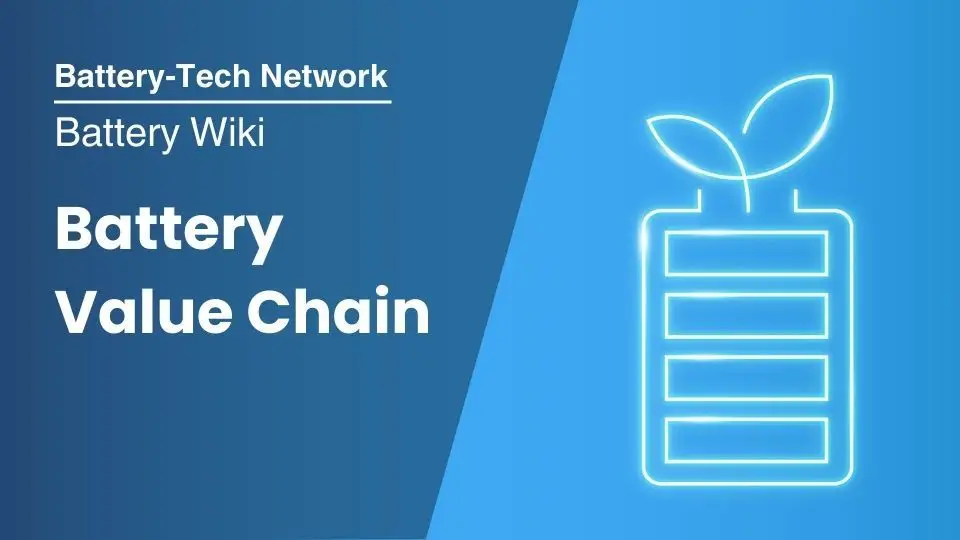The battery value chain encompasses all the steps involved in the creation, distribution, use, and disposal or recycling of batteries. It is a complex and interconnected process that includes the extraction of raw materials, manufacturing of battery components, assembly of batteries, integration into devices or systems, usage by end consumers, and end-of-life management. Understanding the battery value chain is crucial, especially as the demand for batteries—particularly lithium-ion batteries—surges with the growth of electric vehicles (EVs), renewable energy storage solutions, and portable electronics.
Breakdown of each stage in the battery value chain
1. Raw Material Extraction and Processing
Mining: The value chain begins with the extraction of raw minerals required for battery production. Key materials include lithium, cobalt, nickel, manganese, graphite, and rare earth elements.
- Lithium: Sourced mainly from Australia (hard rock mining) and South America’s “Lithium Triangle” (brine extraction in Argentina, Bolivia, and Chile).
- Cobalt: Predominantly mined in the Democratic Republic of Congo (DRC), accounting for about 70% of global production.
- Nickel and Manganese: Extracted in countries like Indonesia, the Philippines, Russia, and Canada.
- Graphite: Major producers include China, which dominates the production of both natural and synthetic graphite.
Processing and Refinement: Extracted minerals are processed and refined to achieve the purity levels required for battery-grade materials. This often involves chemical treatments and purification processes.
- Environmental and Ethical Considerations: The mining and processing stages raise concerns over environmental impacts, such as habitat destruction, water usage, and pollution, as well as social issues like labor conditions and community displacement.
2. Materials Manufacturing
Cathode Materials: The cathode is a crucial component that often includes lithium combined with other metals (e.g., lithium cobalt oxide, lithium iron phosphate, lithium nickel manganese cobalt oxide).
Anode Materials: Typically made from graphite, but silicon and lithium metal anodes are emerging technologies.
Electrolytes and Separators: Production of liquid electrolytes that facilitate ion flow, and separators that prevent short circuits while allowing ion exchange.
Binders and Conductive Additives: Materials that hold the active particles together and enhance electrical conductivity.
3. Battery and Cell Manufacturing
Cell Assembly: Battery cells are assembled by combining the cathode, anode, separator, and electrolyte in a controlled environment to form cells. This process requires precision to ensure safety and performance.
Form Factors: Cells can be cylindrical, prismatic, or pouch-shaped, depending on the application.
4. Module and Pack Assembly
Battery Modules: Multiple cells are assembled into modules, incorporating physical supports and thermal management systems.
Battery Packs: Modules are further integrated into packs, which include battery management systems (BMS) for monitoring and controlling performance, safety features, cooling systems, and housing.
5. Integration into Applications
Electric Vehicles (EVs): Battery packs are installed in EVs, which is currently the largest driver of growth in the battery market.
Energy Storage Systems (ESS): Batteries are used for grid storage to support renewable energy sources like wind and solar.
Consumer Electronics: Smartphones, laptops, and other portable devices rely on advanced batteries for power.
Industrial Applications: Forklifts, backup power supplies, and other industrial equipment use batteries for operation.
6. Battery Distribution and Sales
Supply Chain Logistics: Batteries and battery-powered products are distributed globally, involving transportation, warehousing, and retail strategies.
Aftermarket Services: This includes maintenance, replacement parts, and other services supporting battery-operated products.
Consumer Use: End-users operate devices powered by batteries, the performance and lifespan of which depend on usage patterns and charging behaviors.
Commercial and Industrial Use: Businesses and industries utilize batteries in various capacities, influencing overall demand and innovation in battery technologies.
7. End-of-Life Management and Recycling
Collection and Sorting: Used batteries are collected from consumers and businesses for recycling.
Recycling Processes: Batteries undergo mechanical and chemical processes to recover valuable materials like lithium, cobalt, nickel, and manganese.
- Hydrometallurgical Processing: Uses aqueous chemistry for metal recovery.
- Pyrometallurgical Processing: Involves high-temperature smelting.
Second-Life Applications: Batteries that no longer meet the performance requirements for their original application may be repurposed for less demanding uses, like stationary energy storage.
Waste Management: Proper disposal of unrecyclable components is essential to minimize environmental impact.
Supporting Areas
Research and Development (R&D): Continuous innovation is critical for improving battery performance, safety, cost-effectiveness, and sustainability. Research and development is therefore an essential part of the battery value chain and may contribute to each stage.
Policy and Regulation: Governments play a role by setting standards, providing incentives, and regulating environmental and safety practices. It impacts the battery value chain in many ways.
Trade Policies: Influence global supply chains through tariffs, export controls, and trade agreements. Geopolitical trade agreements or restrictions can have a significant impact on the local battery supply and battery value chain.
Environmental Regulations: Aim to reduce the ecological footprint of battery production and disposal. Simultaneously, it may have an impact on the advancement of the battery value chain and the battery manufacturing industry.
Battery Market Dynamics
Advancements: Solid-state batteries, alternative chemistries (e.g., sodium-ion, lithium-sulfur), and improved manufacturing techniques.
Infrastructure Development: Building charging networks for EVs, battery swapping stations, and energy storage facilities.
Workforce Development: Training and education programs to develop the necessary skills for the evolving battery industry.
Supply and Demand Trends: Growing demand for batteries is driving investments in mining, manufacturing capacity, and technological innovation.
Geopolitical Factors: Control over raw materials and battery production is strategically important, leading to competition and cooperation among nations.
Economic Considerations: Economies of scale, cost reductions through technological advancements, and fluctuations in material prices impact the value chain.
Key Challenges in the Battery Value Chain
Resource Constraints: Limited availability of critical minerals can lead to supply bottlenecks and price volatility.
Environmental Impact: Mining and processing activities can cause significant ecological damage if not managed responsibly.
Ethical Concerns: Issues such as child labor and poor working conditions in mining regions, particularly in the DRC for cobalt.
Technological Barriers: Achieving higher energy densities, faster charging times, and longer lifespans without compromising safety.
Recycling and Sustainability: Improving recycling rates and developing efficient, cost-effective recycling technologies.
Emerging Trends in Energy Storage
Diversification of Supply Sources: Efforts to develop new mining sites and refine materials in different regions to reduce dependency on specific countries.
Material Innovation: Research into alternative materials that are more abundant, less expensive, or environmentally friendly.
Vertical Integration: Companies are increasingly integrating multiple stages of the value chain to secure supply and reduce costs.
Digitalization: Use of digital technologies (e.g., AI, IoT) for better monitoring, optimization, and management across the value chain.
Policy Initiatives: Governments are introducing policies to support domestic battery industries, such as subsidies, grants, and infrastructure investment.
In Conclusion
The battery value chain is vital for the transition to sustainable energy and transportation systems. It involves a multitude of players, from miners and manufacturers to technology companies and policymakers. As the world moves towards electrification and renewable energy, the efficiency, resilience, and sustainability of the battery value chain become increasingly crucial. Addressing the challenges and leveraging the opportunities within this value chain will play a significant role in shaping the future of global energy and mobility landscapes.
















